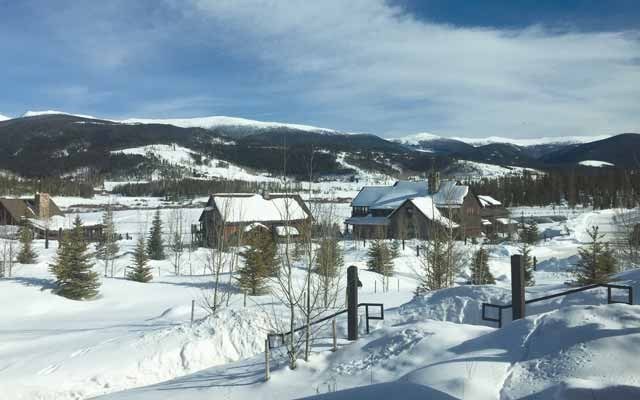Long ago, in a valley outside Tabernash, Colorado, the Ute and Arapahoe tribes decided to end their longstanding feud. So they buried the devil in a mountain, but left his thumb sticking out to remind them of the horror of war. Much later, in 1937, Devil's Thumb Ranch started as a dairy. Then it morphed into a Nordic ski area used for high-altitude training. By 2001, when telecom entrepreneurs Bob and Suzanne Fanch bought the property, it was a 400-acre ranch with rustic cabins and pipes prone to freezing.
Locals debated the ranch's future fate. Would it be condos? Another golf course? Instead, the Fanches bought up six thousand acres of adjacent properties, and turned Devil's Thumb Ranch into one of the world's top eco-resorts.
Nowadays, visitors enjoy Nordic skiing, snowshoeing and fat biking in winter, and mountain biking, hiking and ziplining in summer. Rustic cabins are out, and upscale cabins and lodge rooms are in. The resort lives up to its image: luxurious but unpretentious and environmentally friendly, a real Colorado experience. And an inspiration for other resorts to follow.
Recycled building materials
The developed portion of the ranch — two lodges, restaurants, event spaces, yoga studio, spa — occupies only 10 per cent of the total land. "We really have a very small footprint. (The Fanches) feel that it's important to consider the land first, and the sustainability of materials used," said general manager Doug Libby of the Fanch philosophy.
The ranch's recycling initiatives extend way beyond paper and plastic. Since the mountain pine beetle outbreak in 1996, Colorado's lodgepole pines have been decimated. Devil's Thumb's beetle kill program involves not only removing rotten trees and replacing them with new saplings, but also recycling the materials into interior walls and ceiling beams in the lodges and the spa. The flooring is recycled spruce.
The Fanches also arranged to have two Civil War era barns — one from Indiana, one from Ohio — relocated to the ranch for use as event spaces. Midwest barns in Colorado? "Many buildings in this area were built and homesteaded by families from the east and Midwest," Libby said. "So they fit in with the architecture to look and feel authentic." The High Lonesome Barn accommodates 350 people. In the Broad Axe Barn, you can still see the axe marks where some Indiana builder cut into the beams.
The huge fireplace in the ranch's Hex restaurant was built from rock-slide stone found on the property, and the parking lots are recycled asphalt. The sustainability philosophy extends to areas the resort hopes guests never see, like the filtration system that breaks down bacteria in the wastewater.
Solar Program
Walking around their lodge rooms, guests notice toasty toes. That's because a solar-powered heating system is installed beneath the floors of the main lodge, the High Lonesome Lodge and the maintenance building. Devil's Thumb has the state's largest privately owned, solar-panel system. "We have over 300 days of sunshine here," Libby said. "So it works very well for us."
How to become a leading eco retreat
How do you transform an old ranch into a leading eco-retreat? Commitment, discipline and money.
"I think it needs to be part of your mission statement," Libby said. "We take our lead from Bob and Suzanne. They're committed to treading lightly, and being responsible stewards in every facet of the operations."
With 300 employees, Devil's Thumb Ranch is the county's second biggest employer. Instilling environmental values in employees is crucial. "It may be one thing to have the vision, but then as the staff, we have to carry it on," Libby explained. "We have to communicate it and be aware of it as we're making purchases or other decisions."
The upfront costs can be high — Libby admitted it would have been easier to cut corners by buying from the local lumberyard rather than dismantling and shipping 150 year-old barns across the country — but green initiatives eventually pay off, and not just in feel-good ways. "From a business standpoint, the accolades will come. I think that the general public, and business in general, look for those things that prove that development and environmental sensitivity can coexist," he said. In addition to garnering many awards and spots on Top-10 lists, the ranch has won customer loyalty. Between the mountain setting, activities, comfort and environmental sensibilities, some families return year after year.
Beyond the luxury mattresses and spa products, you catch the faint tune of a John Denver song. Eventually my conversation with Libby turns to that famous 1970s musician and Colorado environmentalist. Libby grew up near Boulder. His hospitality career took him out of state for decades, until returning to Colorado last May. It's good to be home. "My wife would say I get teary-eyed when I hear Rocky Mountain High," he admitted. Which may just be an employee requirement built into Devil's Thumb's mission statement.




